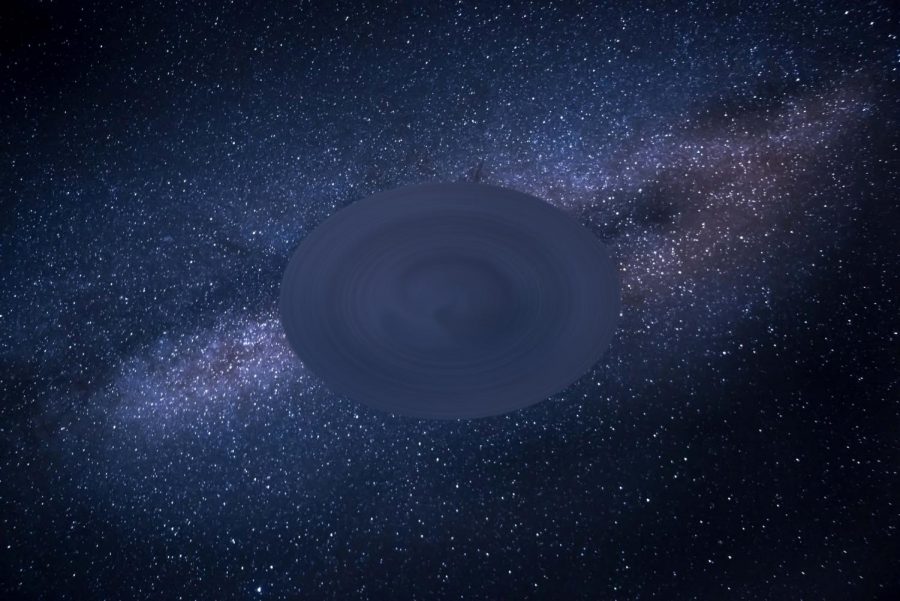The world could end tomorrow…
Black holes: What are they and why should you care?
Image from Pexels.com, modified by Cameron Wilson with Photoshop
This image is a realistic interpretation of a black hole bending the fabric of spacetime.
May 10, 2019
People are selfish; it’s a part of who we are. Naturally humans will worry about problems in their lives that affect how they operate and how they appear to others. This can and usually does lead to people putting themselves at the center of their universe subconsciously, or sometimes even consciously. However, scientists have recently proven the long-suspected existence of black holes, which should be putting priorities into perspective for all of humankind.
Black holes are a point in spacetime where normal physics no longer applies. That said, now is a perfect time to consider our true place in the universe and how meaningless to it we truly are.
The average person’s view on what exactly a black hole is tends to be flawed. A black hole has a pull of gravity so strong that light cannot escape from its surface. This also bends spacetime in and around the black hole. Contrary to popular belief, black holes don’t actually move, well, most of the time they don’t. Earth’s land telescopes are not very effective considering what they are used for and this is because space is so vast.
“The best picture of the moon from earth wouldn’t be able to see an orange on its surface,” science teacher Jason Hensel said.
The image of the black hole isn’t actually an image, but an infrared scan of plasma from a star being sucked into the black hole. In order to even get this image, our planet was essentially turned into a giant telescope.
“ You’re not actually seeing it, but the effect around it,” science teacher Clint Van Fossen said.
In order to create this image of a black hole, Earth was turned into a giant telescope with telescopes worldwide being synced together and pointed at a certain point in spacetime. For two years, readings were taken of said point and eventually the image was created, Hensel says.
Think of a black hole as a giant pothole with an infinite force of gravity so it doesn’t go anywhere. However, in very rare circumstances a black hole can begin to wander. Wandering black holes are created when a black hole swallows two or more stars and at the same time one star pushes the other star into said black hole. This also pushes the black hole causing it to move very fast due to the gravitational forces at play.
Black holes are usually formed when a star goes supernova. Supernovae occur when a star of sufficient mass dies. However, the mass of a giant star is not the only amount of mass that can become a black hole, in fact, any mass can become a black hole. Set mass can and will become a black hole when a set mass reaches its Schwarzschild’s radius. The Schwarzschild radius is the size a mass must reach in order to become a black hole.
In order to explain how this works Imagine that you could shrink Earth infinitely. Earth as it is now has an escape velocity of roughly 11,000 kilometers per hour (escape velocity refers to how fast one would have to go in order to overpower Earth’s force of gravity to go elsewhere in spacetime). When our planet reaches a diameter of nine millimeters, Earth would have to collapse inward in order compensate for its density which forms a black hole. The nine millimeters is the Schwarzschild’s radius of Earth,Van Fossen says.
Black holes don’t stay around forever. They are constantly losing mass to what is known as Hawking radiation. Think of a black hole as a puddle of water. Hawking radiation would be the equivalent of evaporation. The size of the black hole says how long the black hole will resist what is effectively black hole evaporation.
The gravitational force of a black hole is not the only threat they provide. Black holes, specifically supermassive black holes, are notorious for gulping down more matter than they can handle.
When this happens, star matter is vomited up as super potent radiation in a cone shape radiating as much energy as a thousand or more galaxies per second. These are known as quasars, and even though quasars tend to be very far away, the results are some of the brightest objects in our range of view in the universe.
What does this have to with me? Why should I care? This question has been asked too many times. Too often we humans concern ourselves with such meaningless things such as freaking out over failing a test or being overly dramatic about the next dance or even what people say on social media.
The need for someone to care greatly about science all the time should not be what is taken away from this column. Instead, try to realize the universe does not revolve around you.
Knowing one’s place is important not only for perspective, but also to know what truly threatens you. While the most likely way the world could end are quasars, it is still important to know what’s out there in our universe not only for survival, but to know one’s place in this vast world.
“It’s always the little things that lead to big discoveries,” senior Piper Thomas said.







